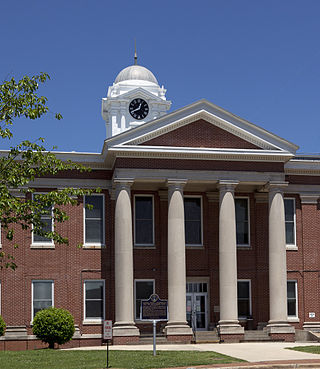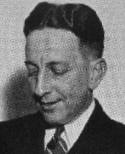
Scottsboro is a city in and the county seat of Jackson County, Alabama, United States. The city was named for its founder Robert T. Scott. As of the 2020 census, the population of the city is 15,578.

The Scottsboro Boys were nine African American male teenagers accused of raping two white women in 1931. The landmark set of legal cases from this incident dealt with racism and the right to a fair trial. The cases included a lynch mob before the suspects had been indicted, all-white juries, rushed trials, and disruptive mobs. It is commonly cited as an example of a legal injustice in the United States legal system.
Batson v. Kentucky, 476 U.S. 79 (1986), was a landmark decision of the United States Supreme Court ruling that a prosecutor's use of a peremptory challenge in a criminal case—the dismissal of jurors without stating a valid cause for doing so—may not be used to exclude jurors based solely on their race. The Court ruled that this practice violated the Equal Protection Clause of the Fourteenth Amendment. The case gave rise to the term Batson challenge, an objection to a peremptory challenge based on the standard established by the Supreme Court's decision in this case. Subsequent jurisprudence has resulted in the extension of Batson to civil cases and cases where jurors are excluded on the basis of sex.
Powell v. Alabama, 287 U.S. 45 (1932), was a landmark United States Supreme Court decision in which the Court reversed the convictions of nine young black men for allegedly raping two white women on a freight train near Scottsboro, Alabama. The majority of the Court reasoned that the right to retain and be represented by a lawyer was fundamental to a fair trial and that at least in some circumstances, the trial judge must inform a defendant of this right. In addition, if the defendant cannot afford a lawyer, the court must appoint one sufficiently far in advance of trial to permit the lawyer to prepare adequately for the trial.
Strauder v. West Virginia, 100 U.S. 303 (1880), was a landmark decision of the Supreme Court of the United States about racial discrimination and United States constitutional criminal procedure. Strauder was the first instance where the Supreme Court reversed a state court decision denying a defendant's motion to remove his criminal trial to federal court pursuant to Section 3 of the Civil Rights Act of 1866.

Samuel Simon Leibowitz was a Romanian-born American criminal defense attorney. He was best known for representing the Scottsboro Boys, and later became a justice of the New York State Supreme Court.
Swain v. Alabama, 380 U.S. 202 (1965), was a case heard before the Supreme Court of the United States regarding the legality of a struck jury.
Whitus v. Georgia, 385 U.S. 545 (1967), found in favor of the petitioner (Whitus), who had been convicted for murder, and as such reversed their convictions. This was due to the Georgia jury selection policies, in which it was alleged racial discrimination had occurred.

Thomas E. Knight, Jr. was an American lawyer and politician who served as the 13th Lieutenant Governor of Alabama from 1935 to 1937, and the 19th Attorney General of Alabama from 1931 to 1935. He was a native of Greensboro, Alabama.
Edmonson v. Leesville Concrete Company, 500 U.S. 614 (1991), was a United States Supreme Court case which held that peremptory challenges may not be used to exclude jurors on the basis of race in civil trials. Edmonson extended the court's similar decision in Batson v. Kentucky (1986), a criminal case. The Court applied the equal protection component of the Due Process Clause of the Fifth Amendment, as determined in Bolling v. Sharpe (1954), in finding that such race-based challenges violated the Constitution.
Racial discrimination in jury selection is specifically prohibited by law in many jurisdictions throughout the world. In the United States, it has been defined through a series of judicial decisions. However, juries composed solely of one racial group are legal in the United States and other countries. While the racial composition of juries is not dictated by law, racial discrimination in the selection of jurors is specifically prohibited. Depending on context, the phrases "all-white jury" or "all-black jury" can raise the expectation that deliberations may be unfair.
Hale v. Kentucky, 303 U.S. 613 (1938), was a United States Supreme Court case relating to racial discrimination in the selection of juries for criminal trials. The case overturned the conviction of an African American man accused of murder because the lower court of Kentucky had systematically excluded African Americans from serving on the jury in the case. NAACP counsel, including Charles H. Houston, Leon A. Ransom and Thurgood Marshall, represented Hale.
Hernandez v. New York, 500 U.S. 352 (1991), was a decision by the United States Supreme Court, which held that a prosecutor may dismiss jurors who are bilingual in Spanish and English from juries that will consider Spanish-language testimony.
Vasquez v. Hillery, 474 U.S. 254 (1986), is a United States Supreme Court case, which held that a defendant's conviction must be reversed if members of their race were systematically excluded from the grand jury that indicted them, even if they were convicted following an otherwise fair trial.
Patterson v. Alabama, 294 U.S. 600 (1935), was a United States Supreme Court case which held that an African-American defendant is denied due process rights if the jury pool excludes African-Americans.
Davis v. Ayala, 576 U.S. 257 (2015), was a case in which the Supreme Court of the United States upheld a death sentence of a Hispanic defendant despite the fact that all Blacks and Hispanics were rejected from the jury during the defendant's trial. The case involved a habeas corpus petition submitted by Hector Ayala, who was arrested and tried in the late 1980s for the alleged murder of three individuals during an attempted robbery of an automobile body shop in San Diego, California in April 1985. At trial, the prosecution used peremptory challenges to strike all Black and Hispanic jurors who were available for jury service. The trial court judge allowed the prosecution to explain the basis for the peremptory challenges outside the presence of Ayala's counsel, "so as not to disclose trial strategy". Ayala was ultimately sentenced to death, but he filed several appeals challenging the constitutionality of the trial court's decision to exclude his counsel from the hearings.
Flowers v. Mississippi, No. 17–9572, 588 U.S. 284 (2019), is a United States Supreme Court decision regarding the use of peremptory challenges to remove black jurors during a series of Mississippi criminal trials for Curtis Flowers, a black man convicted on murder charges. The Supreme Court held in Batson v. Kentucky that the use of peremptory challenges solely on the basis of race is unconstitutional. This case examined whether the Mississippi Supreme Court erred in how it applied Batson to this case. The Supreme Court ruled that Flowers' case fell under Batson and that the state inappropriately removed most of the potential black jurors during the trials.
Powers v. Ohio, 499 U.S. 400 (1991), was a United States Supreme Court case that re-examined the Batson Challenge. Established by Batson v. Kentucky, 476 U.S. 79 (1986), the Batson Challenge prohibits jury selectors from using peremptory challenges on the basis of race, ethnicity, gender, and sex. Powers expanded the jurisdictions of this principle, allowing all parties within a case, defendants especially, to question preemptory challenges during a jury selection, regardless of race. This holding was protected under the Equal Protection Clause of the Fourteenth Amendment.



